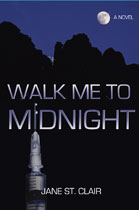Romero Ruins
By Jane St. Clair
A Yaqui woman told me she likes to walk in Romero Ruins where the Hohokam lived hundreds of years ago. These ruins are the remains of prehistoric villages in Catalina State Park, just north of Tucson, Arizona. The Hohokam lived there between 500 and 1500 AD, and then disappeared. No one knows why. Their very name means “the people who have left.”
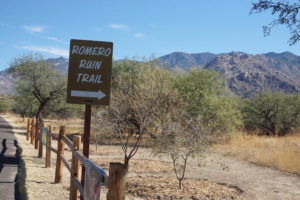 Anyway, she was walking in Romero Ruins when she picked up some bits of pottery. She took them home. Then for the next five nights, she could not sleep. When she finally did sleep, she had a bad dream. A strange man came to her and spoke in a strange language, yet she could understand him. The next day she knew she must return the pottery chards to Romero Ruins.
Anyway, she was walking in Romero Ruins when she picked up some bits of pottery. She took them home. Then for the next five nights, she could not sleep. When she finally did sleep, she had a bad dream. A strange man came to her and spoke in a strange language, yet she could understand him. The next day she knew she must return the pottery chards to Romero Ruins.
In the Yaqui tradition, you don’t just remove something from a place, not even a leaf, without giving back something of your own.  You especially do not take a work of art like pottery because every work of art has part of the artist’s spirit/soul in it. You are respectful. You don’t mess with that.
You especially do not take a work of art like pottery because every work of art has part of the artist’s spirit/soul in it. You are respectful. You don’t mess with that.
The Yaqui believe even that even before the artist turns it into pottery, the clay itself is sacred, and the clay itself remembers who made it into a work of art.
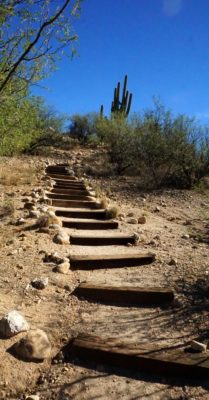 I was thinking about these things when I last climbed the stairs to Romero Ruins. It is a beautiful spot, very high with beautiful views. I was thinking that it’s a great spot for villages because it is near two big washes and has beautiful panoramic views of mountains and sunsets.
I was thinking about these things when I last climbed the stairs to Romero Ruins. It is a beautiful spot, very high with beautiful views. I was thinking that it’s a great spot for villages because it is near two big washes and has beautiful panoramic views of mountains and sunsets.
About 300 Hohokam lived in walled villages on this 15-acre spot. They were farmers who knew how to irrigate the desert. They had two large ball courts, and probably played tournaments against nearby villages. Since they made seashell jewelry, archaeologists think they went to the Gulf of California to trade.
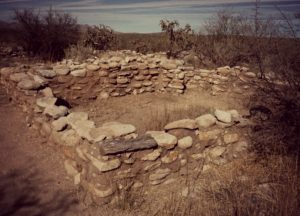
I get the feeling they were a happy people.
Walking around there gives you the spooky sense of times past and of the lives of those who came before us. But it’s not the scary-spooky you get in a cemetery, it’s more the sacred feeling of other times, other worlds. I understand why the Yaqui believe it is wrong to disturb even a bit of this place.
Romero Ruins also has what’s left of Francisco Romero’s Ranch. The prehistoric ruins are mixed up with the crumbling cobbles of his ranch.
One last story about Romero Ruins–
A hundred years ago, a rumor went around that the Spaniards left a vast treasure of gold buried in a mission called Circu out here.

There was no mission, and there was no gold, but there were many, many looters who walked around looking for both. They took pottery chards, jewelry and other Hohokam things.
I can’t help but wonder if those looters ever got bad dreams about strangers.

To plan your visit to Romero Ruins, check out the Catalina State Park’s website.
Tags: Arizona · Jane St. Clair · Tucson · Tucson Tourism
Mount Lemmon by Jane St. Clair
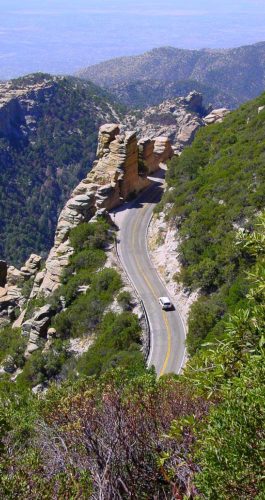 Tucson wouldn’t be Tucson without Mount Lemmon, the great rock and woods colossus in the Santa Catalinas. This mountain is Tucson’s upstairs, and it only takes about an hour to get to the top.
Tucson wouldn’t be Tucson without Mount Lemmon, the great rock and woods colossus in the Santa Catalinas. This mountain is Tucson’s upstairs, and it only takes about an hour to get to the top.
In summer, Mount Lemmon’s temperature is a shady 80 degrees compared to the desert’s 110-degree inferno. If you go upstairs in October or November, the season will change from mid-summer on the desert floor to autumn on the mountaintop. In December, you can go swimming downstairs and then go skiing upstairs in the snow.
The name of the long, twisty scary road up Mount Lemmon is Sky Island Scenic road. The way is high and steep, with pull-outs where you can get out of your car or off your bike. You can stand and look at landscape vistas that stretch for miles below.
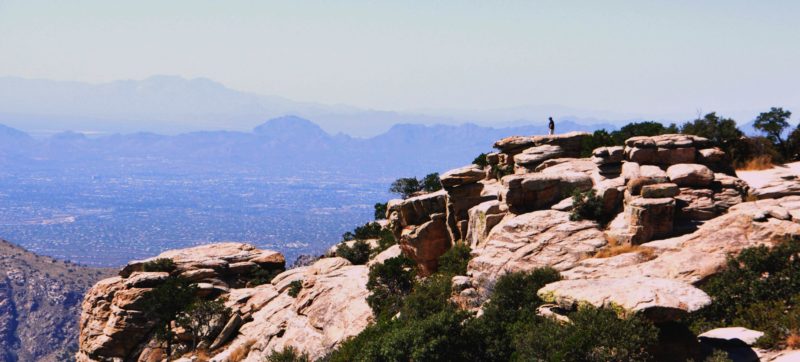
The views make your physical being feel small, and yet your mind expands in awareness of the vast, pure Western space. No one can fence that in, so don’t even try.
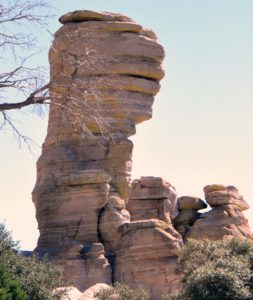 Along the way up Mount Lemmon are great rock formations with horizontal timelines that mark past millennia. Some form big natural cathedrals of stone, looking as if some great hand twisted them into these amazing unlikely shapes.
Along the way up Mount Lemmon are great rock formations with horizontal timelines that mark past millennia. Some form big natural cathedrals of stone, looking as if some great hand twisted them into these amazing unlikely shapes.
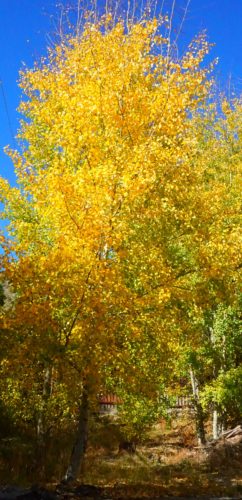 We started in the desert full of cactus, lizards and scorpions.
We started in the desert full of cactus, lizards and scorpions.
But now we are going through foothills with seaweedish ocotillo, and then past bright green chaparral. Higher up we come to forest land, and higher still, to magnificent conifer woods, full of peaceful green triangles. We are 9000 feet high now.
Now we’re in a forest meadow full of quaking Aspens, these white-barked trees that keep waving their little yellow hands back and forth. So many leaves quake at once that it feels as if we’re surrounded by quaking yellow polka dots.
A trail leads through oaks and maples colored in fierce reds, yellows and oranges. Soon these color energies will dissolve into a winter of black branches and white snow, but wow! what a spectacle it is now!
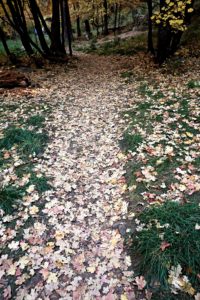
We’re hiking on a natural carpet of fallen leaves that make crispy noises under our feet.
In a month or two this trail will be white with snow and blue silvery ice but now its trees are blazing with colors. Downstairs in Tucson, away from the drama of changing seasons, it is still summer, always summer, eternally summer. And yet summer seems so far away from here.
Before we go back, we look down to another vista one more time. It’s still so beautiful.
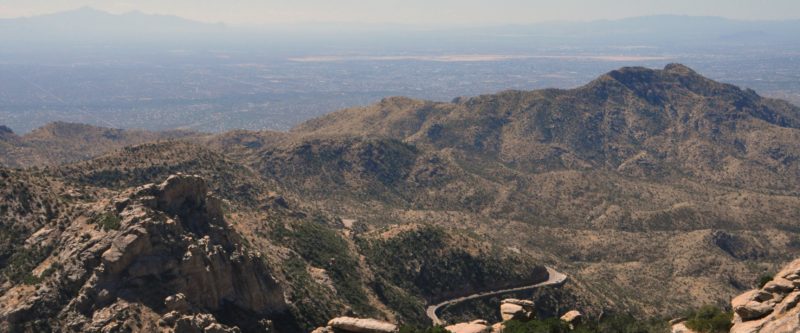
John Muir wrote, “Your mountain is calling you, so go on your way.” Mount Lemmon calls, and she knows your name.
 To download a free tourist app from the University of Arizona that works as a cool science guide to Mount Lemmon, go to science tour app.
To download a free tourist app from the University of Arizona that works as a cool science guide to Mount Lemmon, go to science tour app.
For more nature essays about mountains in Tucson, try Crouching Tiger, Hidden Dragons about Pusch Ridge, and A Beautiful and Benign Science about Kitt Peak.

Tags: Arizona · Jane St. Clair · Mount Lemmon · nature essay · Tucson Tourism
September 28th, 2017 · No Comments
Valley of the Moon by Jane St. Clair
Once upon a time the family of a little girl suffering from tuberculosis brought her to Tucson. It was common in the 1910s for sick people to come here. The girl’s parents were hoping Arizona’s warm desert air would cure her.
The little girl lay in her bed, looking out her window at barren desert wilderness. 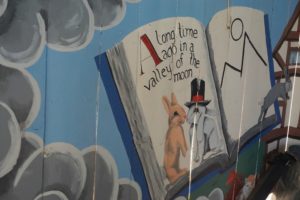 A neighbor boy named George Phar Legler, felt compassion for her, and made her a window box full of fairy castles. The box even had a lake and a waterfall that could flow whenever George poured buckets of water over it.
A neighbor boy named George Phar Legler, felt compassion for her, and made her a window box full of fairy castles. The box even had a lake and a waterfall that could flow whenever George poured buckets of water over it.
Sadly, the little girl died, but George Legler had found his mission in life – to live a life of kindness, and to create places where the human imagination can run free — places where the fairies can live.
Using stone, sand, mail order cement and whatever he had, George Legler built a fantasy-land on two-and-a-half acres in Tucson. When he finished, he named it “The Valley of the Moon.”
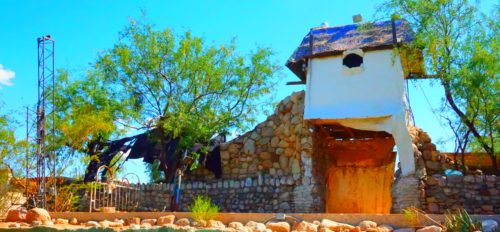
A friend of Legler once said, “George didn’t just believe in fairies. He was surrounded by them.”  George practiced spiritualism, a religion that teaches that the world is full of living supernatural creatures. Ghosts, sprites and fairies were very real to George Legler. He lived in the Valley of the Moon, sometimes sleeping in caves near his Enchanted Garden, and other times just bunking under the bright stars of the black desert nighttime sky.
George practiced spiritualism, a religion that teaches that the world is full of living supernatural creatures. Ghosts, sprites and fairies were very real to George Legler. He lived in the Valley of the Moon, sometimes sleeping in caves near his Enchanted Garden, and other times just bunking under the bright stars of the black desert nighttime sky.
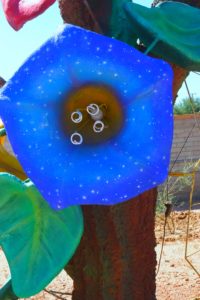
He made statues and houses where fairies, gnomes, and even tree spirits could share the space with him. Today it’s cool to to catch fairies. George Legler knew how to do it a hundred years ago.
Legler opened the Valley of the Moon to the public in 1926. Then and now the Valley is full of random twists, like smiling trees from a miniature golf course and a green snake made from oatmeal boxes. It has this Wild West masculine vibe to it – as if Pecos Bill were designing fairy castles for Disney princesses.
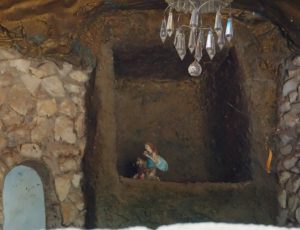
By the 1950s, thousands of visitors were 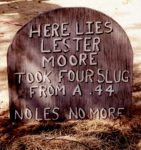 visiting the Valley of the Moon. But as Legler’s health grew worse, he lived in the Valley as a hermit,unable to maintain his fantasy-land. One night vandals broke into the property and smashed the fairy castles and gnome statues.This crime hurt George very much! The gnomes were so real to him that he created gravestones for them.
visiting the Valley of the Moon. But as Legler’s health grew worse, he lived in the Valley as a hermit,unable to maintain his fantasy-land. One night vandals broke into the property and smashed the fairy castles and gnome statues.This crime hurt George very much! The gnomes were so real to him that he created gravestones for them.
In every fairy tale, good always overcomes evil, and that’s what happened in this story. 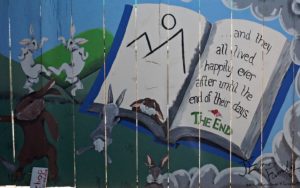 Neighborhood teenagers, curious about what was behind the strange fences, also broke into the Valley of the Moon. This time they offered to restore it according to George Legler’s original vision.
Neighborhood teenagers, curious about what was behind the strange fences, also broke into the Valley of the Moon. This time they offered to restore it according to George Legler’s original vision.
 In 1975, the Valley of the Moon was added to the Arizona Register of Historic Places, and in 2011, to the National Register of Historic Places. The Valley of the Moon with its whimsy and fairies and stone castles lives today happily ever after.
In 1975, the Valley of the Moon was added to the Arizona Register of Historic Places, and in 2011, to the National Register of Historic Places. The Valley of the Moon with its whimsy and fairies and stone castles lives today happily ever after.
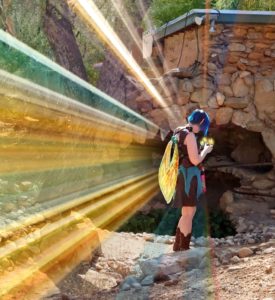
The motto of the Valley of the Moon is “Where the magic of imagination lives free, the spirit of childhood is forever, and Kindness to All is the Golden Key to Happiness.” It’s open at random times, so check their website before your visit. Be aware that real fairies hang out in this Valley. You never know when you’ll see one.
Tags: Valley of the Moon
Famous Rabbits I have Loved
by Jane St. Clair
Rabbits are easy to overlook. You see these little brown creatures you see every day. Rabbits are the wildflowers of the animal kingdom. We take them for granted, but we’d miss them if they weren’t around.
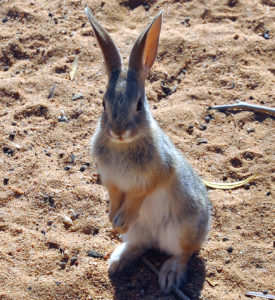
Personally I love rabbits. I’m always happy to come upon one, even though when a rabbit sees me, he’ll usually freeze and hide in plain sight like a two-year-old child. I love their bright black eyes and their round dewdrop bodies, with unlikely Popsicle ears at one end, and big Clarabelle feet at the other. I love how still they can be when they sit and eat or when they just sit and stare, and then how quickly they can move when they want to.
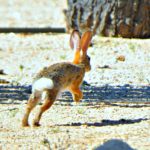
And those amazing back legs are always ready for take-off! Wham! Bang! They sure can take off! Rabbits are fast –but then, they are I-run-away animals that have to flee from the I-will-chase-you-and-eat-you kind.
We’ve been talking about everyday rabbits for a while,  so now let’s hear it for famous rabbits. I love Bugs Bunny with his Brooklyn street-wise accent and the way he turns a carrot into a cigar. I love all the rabbits in Watership Down, but especially Fiver-the-Fearful, who has this untreated anxiety disorder that makes him psychic and able to predict disaster, so his favorite phrase is the sky is falling, the sky is falling.
so now let’s hear it for famous rabbits. I love Bugs Bunny with his Brooklyn street-wise accent and the way he turns a carrot into a cigar. I love all the rabbits in Watership Down, but especially Fiver-the-Fearful, who has this untreated anxiety disorder that makes him psychic and able to predict disaster, so his favorite phrase is the sky is falling, the sky is falling.
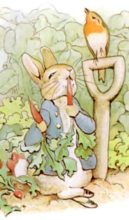 Fiver’s literary opposite is Peter Rabbit, an adventurer with the courage of a lion and the heart of a Robin Hood. Peter thinks every good thing on the planet belongs to us all. I love how Peter hops into Mr. MacGregor’s Garden, ignoring the family tragedy that his father had an “accident” in that very garden and landed up in a pie.
Fiver’s literary opposite is Peter Rabbit, an adventurer with the courage of a lion and the heart of a Robin Hood. Peter thinks every good thing on the planet belongs to us all. I love how Peter hops into Mr. MacGregor’s Garden, ignoring the family tragedy that his father had an “accident” in that very garden and landed up in a pie.
And everyone loves Thumper, the bunny who is Bambi’s friend, if only for his prefect rabbit name. Thumper has the voice of a baby and the wonder of a child.
The White Rabbit in Alice in Wonderland is an anomaly as rabbits go, because I certainly don’t think of rabbits as uptight and worried about clocks and being on time. But then I never believed Br’r Rabbit actually liked sticker bushes until I moved out West, where you see rabbits in cactus patches all the time.
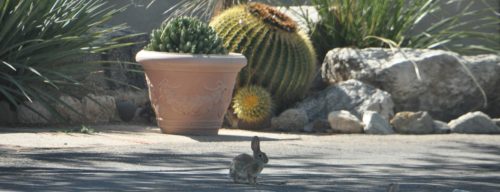
While I’d be very happy to encounter Thumper or Peter Rabbit, I hope I never see Harvey, the six-foot hallucination in the Jimmy Stewart movie. He may be a friendly rabbit but you never know what comes next once you start seeing six-foot tall rabbits.
So, enough for famous rabbits. Let’s return to ordinary ones. If you’re ever lucky enough to find a baby bunny, one small enough to fit in your hand, you’re in for cute overload. I once found one, and dutifully phoned the Sonora Desert Museum for help.
If you’re ever lucky enough to find a baby bunny, one small enough to fit in your hand, you’re in for cute overload. I once found one, and dutifully phoned the Sonora Desert Museum for help.
“If his eyes are open and he has his fur,” the expert said, “then he is able to take care of himself. Just let him loose.”
This seemed incredible and wonderful to me. It reminded me that small miracles are all around us, even in things like every day rabbits. Graham Greene said, “Mortality and death set in when you lose your curiosity and the wonder of every day.” That’s right, and it’s also right that I set him free.







Tags: Arizona · Jane St. Clair · nature essay
Monsoon by Jane St. Clair
Tucson summer is the season of violent monsoon storms. The language of the sky is not the same as the language people use when a monsoon strikes.
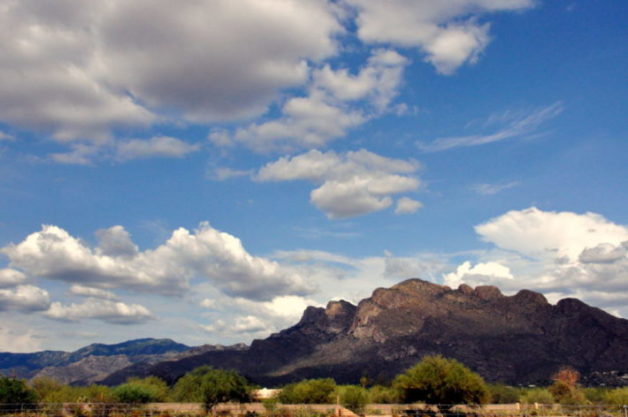
It’s 9 A.M. The sky has no look of danger. If you look closely, though, you can see a storm is literally brewing in the great cauldrons of the Catalina Mountains over Tucson. The storm gods are cooking up something for us today.
ALERT 9 AM … ALERT …ON YOUR CELL PHONE ….ALERT … ALERT ON YOUR TV ….9 AM… Mountain Standard Time… The National Weather Service has issued a storm alert for the city of Tucson and the county of Pima, Arizona …. Expect heavy winds and flooding in some areas… Rivers and washes will be running…
ALERT …. ALERT …. ALERT …. ALERT … ALERT …. ALERT …

It’s 10 AM. The sky is no longer quiet. The place where the sky meets the hot desert earth of summer is now an ominous zone. Something’s got to give. Something will crashing down.
10 AM… MST….ALERT … ALERT … ALERT …FLASH FLOOD WATCH NOW IN EFFECT THROUGH 5 PM MST FOR ALL OF SOUTHEAST ARIZONA …Flash Flooding may occur at times from numerous showers and monsoon storms. Areas along washes…small streams and drainages will be susceptible to flooding. Low water crossings and poorly drained roads may become impassable. Rural and dirt roads will likely become washed out at times.
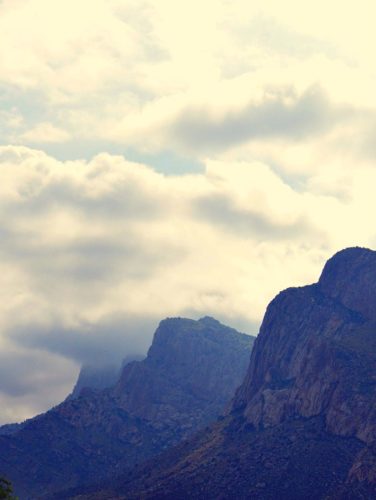
By noon the sky is now scary dark. The storm gods have woken up and ready to throw out their lightning .. and to shake down the thunder from the sky …
ALERT… NOON MST …FLASH FLOOD WARNING NOW IN EFFECT…
If Flash Flooding is observed…
act quickly.
- Move immediately to higher ground. Do not wait for instructions to move.
- If you must evacuate, turn off utilities at the main switches. Do not touch electrical equipment if you are wet.
- Secure your home. Move essential items to an upper floor.
- If you have to leave your home, do not walk through moving water. Six inches of moving water can make you fall.
- Do not drive into flooded areas. If floodwaters rise around your car, abandon your car.
It is 3 PM and dark as pitch. All the animals have gone into hiding. Lightning bolts –zig zag shapes and round shapes– make quick light, then go dark in thundering silence.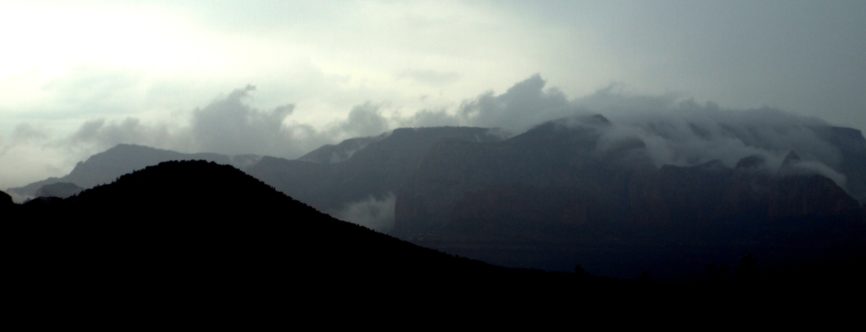 ALERT …. 3 PM ….ALERT …. FLASH FLOODING AND HEAVY RAINS ARE OCCURRING … Fifty roads are closed. If you take a chance and try to drive through a flooded street, your car will stop. If the police come and rescue you, you are subject to Arizona’s Stupid Motorist Law, which requires you to pay for both your rescue and a fine of up to $2,000.
ALERT …. 3 PM ….ALERT …. FLASH FLOODING AND HEAVY RAINS ARE OCCURRING … Fifty roads are closed. If you take a chance and try to drive through a flooded street, your car will stop. If the police come and rescue you, you are subject to Arizona’s Stupid Motorist Law, which requires you to pay for both your rescue and a fine of up to $2,000.
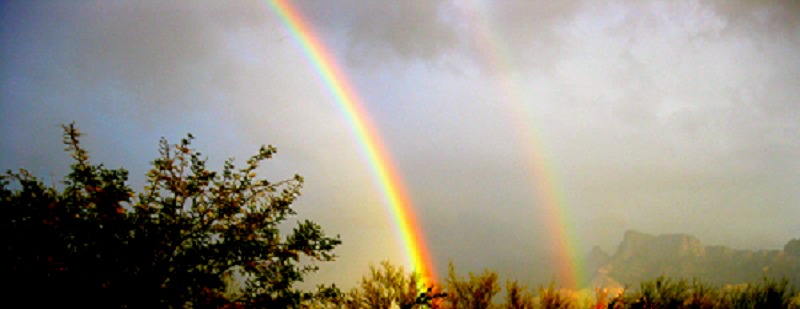 By 5 PM a great double rainbow arches over the sky and reaches across the mountains. The monsoon is over. The rainbows promise peace.
By 5 PM a great double rainbow arches over the sky and reaches across the mountains. The monsoon is over. The rainbows promise peace.
By 8 PM you’re watching the sunset. Your phone buzzes. You have a text.
 ALERT …. ALERT …. ALERT …. 8 PM MST …..ALERT… FLASH FLOOD WARNING NOW IN EFFECT UNTIL 5 PM TOMORROW …………………………………………………………………………………………………………..
ALERT …. ALERT …. ALERT …. 8 PM MST …..ALERT… FLASH FLOOD WARNING NOW IN EFFECT UNTIL 5 PM TOMORROW …………………………………………………………………………………………………………..
Barbara Kingsolver once wrote that when  it comes to thunderstorms and sunsets, Tucson never does anything halfway. To keep track of monsoon storms in Tucson and to get alerts like the ones here, go to the National Weather Bureau website.
it comes to thunderstorms and sunsets, Tucson never does anything halfway. To keep track of monsoon storms in Tucson and to get alerts like the ones here, go to the National Weather Bureau website.
Tags: Monsoon
Lake Havasu City by Jane St. Clair
It’s easy to be a kook in the American West. The distances between houses are so great that you don’t really care what your neighbors think of you. You don’t really have any neighbors.
Robert Paxton McCullough was an Arizona kook. While those of us with ordinary eyes can see only hot desert, he could picture a city. Standing on the courthouse steps in Kingman, Arizona, in 1963, McCullough purchased 26-square miles of desert at $75 an acre. Our visionary would build a shining city on a hill next to Lake Havasu, the artificial lake created by Parker Dam, on barren and hot desert land. Then he’d add London Bridge.

The parcel he bought that day had no roads going to it, no electricity and no water. This would be a problem to the average person. How could you get people to live on the Arizona desert where there’s no way to get there except by airplane?
To our visionary, that was not a problem.
McCullough believed every American should own an airplane  and would do so in the future. He pictured Americans driving McCullough J-2 Gyroplanes instead of cars. Gyros were a cross between airplanes and helicopters. They could take off from an ordinary driveway. Although McCullough’s factories cranked out 200 J-2s, this was one of his few ideas that never made it off the ground.
and would do so in the future. He pictured Americans driving McCullough J-2 Gyroplanes instead of cars. Gyros were a cross between airplanes and helicopters. They could take off from an ordinary driveway. Although McCullough’s factories cranked out 200 J-2s, this was one of his few ideas that never made it off the ground.
By 1971 McCullough was taking out ads in magazines and on television to lure people to move to out to Lake Havasu City. He offered free flights to Arizona and all-expense-paid vacations in Lake Havasu City.  Why shiver through another dreary winter in the Midwest … with your squirrelly baby boomer children in their Davy Crockett hats … when you could live in BEAUTIFUL LAKE HAVASU CITY! with a winter temperature averaging a balmy 70 degrees. (What McCullough’s ads didn’t say is it gets up to 120 degrees in summer.)
Why shiver through another dreary winter in the Midwest … with your squirrelly baby boomer children in their Davy Crockett hats … when you could live in BEAUTIFUL LAKE HAVASU CITY! with a winter temperature averaging a balmy 70 degrees. (What McCullough’s ads didn’t say is it gets up to 120 degrees in summer.)
By 1978 over 137,000 people had taken free vacations in Lake Havasu City. Salesmen driving white Jeeps greeted them when they landed, and wined and dined them for a week. McCullough promised them jobs in his factories that made his chainsaws and outboard motors.
Yet he believed Lake Havasu City needed something more — something awesome cool! …. something Disneylandish! …. a great tourist attraction that everyone would talk about!
That’s when he decided to buy London Bridge and move it 5,285 miles to Lake Havasu City.
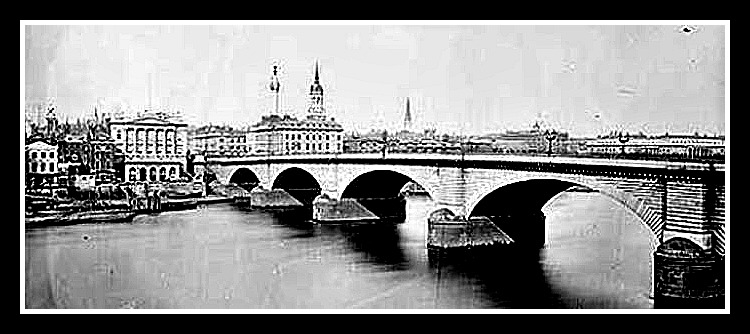
Meanwhile back in England, London Bridge was sinking into the Thames River under the weight of automotive traffic. The British were sentimental about their old bridge dating to 1831. They put it up for auction, but would not sell it to anyone planning to demolish it.
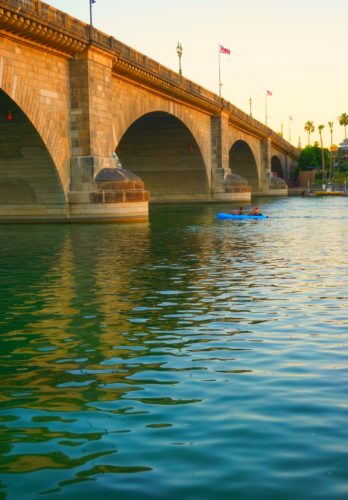 McCullough figured it cost $1.2 million to take the bridge apart and move it to Lake Havasu City. He doubled that, added $1,000 for each year of his life to come up with the romantic and winning bid of $2,460,000.
McCullough figured it cost $1.2 million to take the bridge apart and move it to Lake Havasu City. He doubled that, added $1,000 for each year of his life to come up with the romantic and winning bid of $2,460,000.
Every brick, light post, and decoration on London Bridge got a number before it was packed into boxes and shipped through Long Beach, Calif. At customs, McCullough declared London Bridge as “1 Antique.”
By now the children of Lake Havasu City were singing a new version of the old nursery rhyme … “London Bridge is coming here, coming here, coming here… London Bridge is coming here to our fair city.”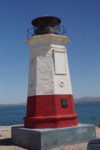 Their parents didn’t believe the bridge story until they saw construction workers putting the bridge together. As an added touch, McCullough and a designer of Disneyland created eleven miniature lighthouses. London Bridge opened in 1971.
Their parents didn’t believe the bridge story until they saw construction workers putting the bridge together. As an added touch, McCullough and a designer of Disneyland created eleven miniature lighthouses. London Bridge opened in 1971.
Today Lake Havasu City has over 54,000 residents. London Bridge is still an awesome cool attraction. As one historian wrote, the miracle of McCullough’s vision was not that he moved London Bridge, but that he could picture a city in a barren desert.
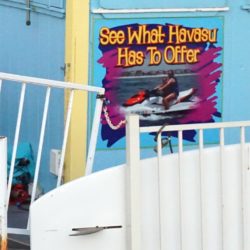 For more information on visiting Lake Havasu City, go to this vacation spot in Arizona!
For more information on visiting Lake Havasu City, go to this vacation spot in Arizona!
“Mute,” Jane’s short story about a confused hospice clown, will be published in Image, a journal of art, faith and mystery.
Tags: Lake Havasu City
Hummingbird Laundry Day by Jane St. Clair
And to what should my wondering eyes appear? A mama hummingbird! who has taken over the clothespins on our laundry line!
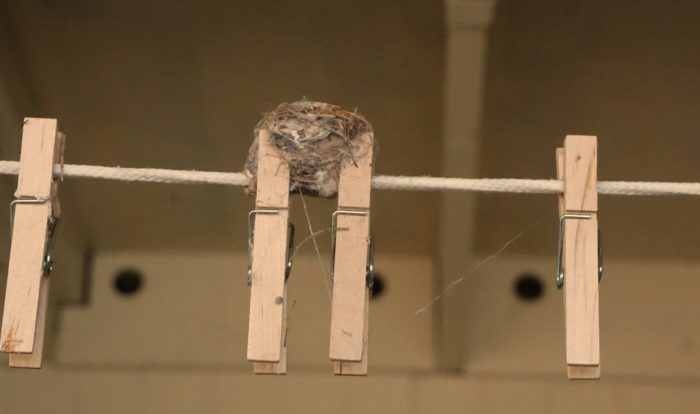
I’ve grown very fond of her, and her name is now Thumbelina.
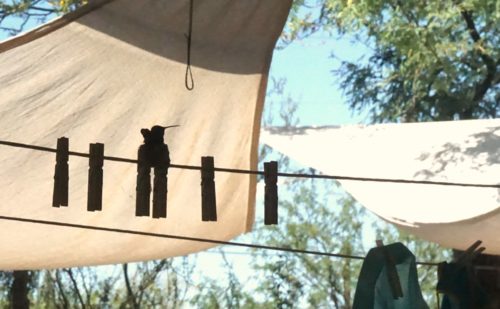
Tags: hummingbird
St. Lawrence by Jane St. Clair
Since two men called St. Lawrence are both Roman Catholic saints of cooking, it is confusing for us.
Now’s the time to clear up our confusion!

St. Lawrence holding his grill
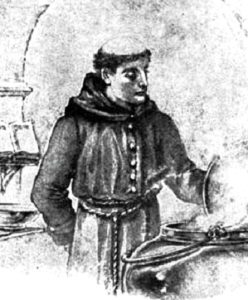
Brother Lawrence with pots and pans
St. Lawrence of Rome should be the saint of grilling,as opposed to cooking. The Romans murdered this poor man by tying him to a grill and burning him to death in 225 A.D. He said as his killers were roasting him, “I’m done on this side. You better turn me over now.” It is no wonder that St. Lawrence of Rome is the saint of comedy as well as cooking.
The second St. Lawrence is very much in style now for two reasons. He is our first celebrity cook, and he invented his own version of mindfulness.
Brother Lawrence of Paris was born into a poor French family in 1614. Like our own Abraham Lincoln, he wanted to go to school and learn to read, but his family could not afford it. He joined the army and received a war injury that left him crippled for life. Brother Lawrence was a big heavy man, and now a bum foot made him even more clumsy and awkward. He took a valet job, waiting on tables and opening doors for rich people.
One day when Brother Lawrence was around 25 years old,  he was looking at a tree sprouting in spring and felt a strong calling to join a monastery. He hoped the monks would let him work in their library, where he’d read and study and become an educated man. Instead, his abbot took one look at our clumsy humble Lawrence and assigned him to permanent kitchen duty.
he was looking at a tree sprouting in spring and felt a strong calling to join a monastery. He hoped the monks would let him work in their library, where he’d read and study and become an educated man. Instead, his abbot took one look at our clumsy humble Lawrence and assigned him to permanent kitchen duty.
I picture Brother Lawrence in the kitchen, as awkward as Peter Boyle’s monster in “Young Frankenstein,” tripping over boxes, spilling hot water, and breaking dishes. He was the kind of guy that other monks would tease.
Although Brother Lawrence felt disappointed to get kitchen duty, he made the best of it. “I shall have to find God among the pots and pans,” he said, vowing to keep his mind on love and God at all times.
 Like anyone who tries mindfulness, Brother Lawrence had a hard time concentrating. His mind kept jumping around in what Buddha called “monkey mind.” Ten years passed before Brother Lawrence reached his mindfulness goal, which was to experience God in every moment of the day –in what he called “Practicing the Presence of God.”
Like anyone who tries mindfulness, Brother Lawrence had a hard time concentrating. His mind kept jumping around in what Buddha called “monkey mind.” Ten years passed before Brother Lawrence reached his mindfulness goal, which was to experience God in every moment of the day –in what he called “Practicing the Presence of God.”
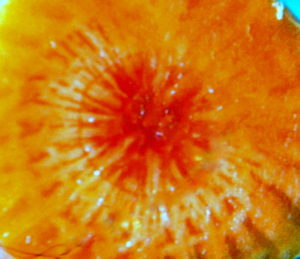
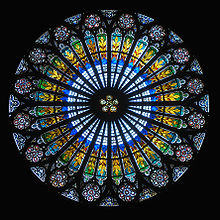
I picture the big guy chopping carrots and seeing cathedral stars in them. I bet he was full of wonder at the inside of an orange pepper, the beauty of a purple eggplant or the splendor of an orange pumpkin with beautiful yellow ribs. I bet he’d see the mushrooms dancing.
As sensitive and sweet as Brother Lawrence was, I bet he felt bad about taking the life of any vegetable. No doubt he’d apologize to a cabbage before he cut into it. I bet he heard the sound of the universe in the squeak of corn husks when he shucked them, and I bet that every time he cooked a meal, he prayed that the food would reflect his love for the other brothers, and God’s love for us all.
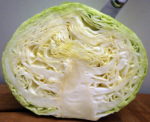 Modern people try to find work they love. Brother Lawrence tried to put love into grunge work that he got stuck with. As the Arabic poet Kahlil Gibran wrote and as Brother Lawrence discovered, the motivation behind your work is all that matters.
Modern people try to find work they love. Brother Lawrence tried to put love into grunge work that he got stuck with. As the Arabic poet Kahlil Gibran wrote and as Brother Lawrence discovered, the motivation behind your work is all that matters.
“It is to weave the cloth with threads drawn from your heart,
even as if your beloved were to wear that cloth.
It is to sow seeds with tenderness and reap the harvest with joy,
even as if your beloved were to eat the fruit.”
Before Brother Lawrence died, his friends insisted that he tell them how he achieved mindfulness. They recorded their conversations into a tiny book that is a practical how-to manual for anyone who wants to try a mindfulness path to spirituality.
The funny thing is that Brother Lawrence’s little book became a classic. That means God gave him the very gift he always wanted – to be an educated, wise man.
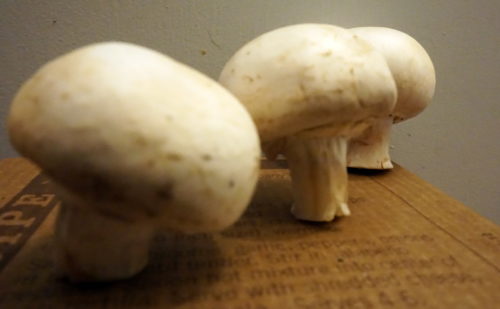
Guess what! You can download Brother Lawrence’s book for free at the Gutenberg Organization
Negative Capability Press accepted Jane’s short story, “The Gerber Secret,” for an upcoming issue of their magazine.
Tags: Uncategorized
Yellow by Jane St. Clair
In the spring of the year the Sonoran Desert goes from light green to yellow.
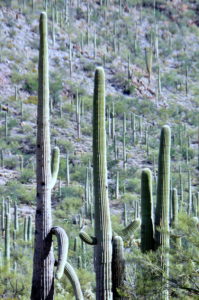
Everywhere you look you see yellow.
Spring picks up her color crayons and throws them all away except for one, and then she colors it all yellow.
Palo verde trees hang heavy with yellow, yellow falls all over their feet, yellow creates a carpet beneath them, as if it had snowed yellow snow. The yellow of palo verde trees against the bright blue Arizona sky is electric … so electric that you feel as if yellow fire alarms are going off in your head.
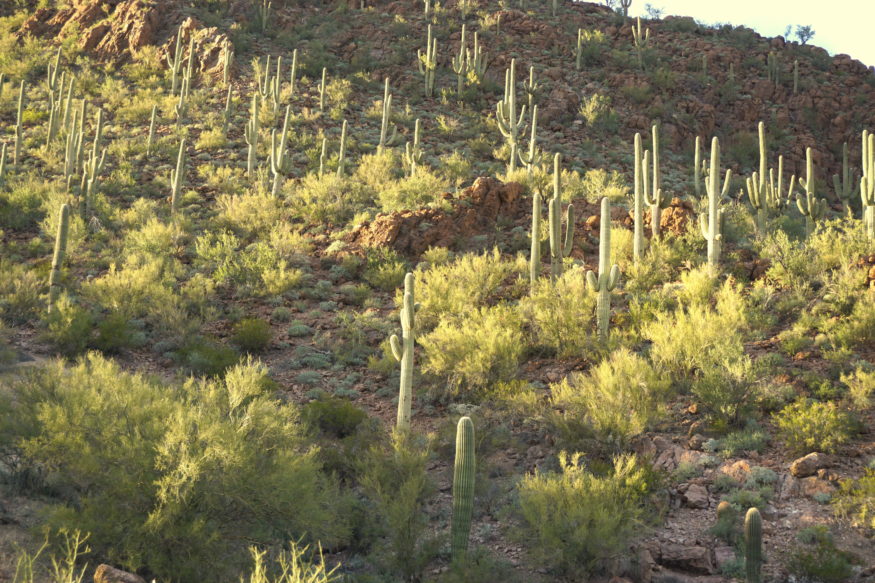
In the spring of year in the Sonoran Desert if you walk in the mountains, if you walk in the gray and black shadow mountains, suddenly you’ll see fields of wildflowers, and pop! They are all yellow.

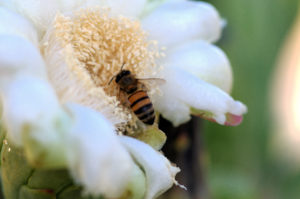
All day long everywhere you look, yellow … the yellow sun lights up yellow wildflowers and gentle yellow wax flowers on the saguaros smiling and welcoming golden bees …
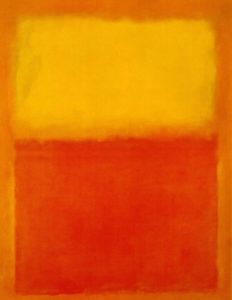 No one can explain yellow to someone who cannot see it. The dictionary says yellow is the color of ripe lemons, but what does that mean? Is the color of your ripe lemons the same color as mine? Just thinking about yellow, that is.
No one can explain yellow to someone who cannot see it. The dictionary says yellow is the color of ripe lemons, but what does that mean? Is the color of your ripe lemons the same color as mine? Just thinking about yellow, that is.
Mark Rothko, the American artist, made gigantic paintings of yellow. Once he painted a huge picture of a yellow square on top of an orange square… so everyone could see the difference between the color yellow and the color orange. Rothko’s idea is simple but yet it is profound in its own way.
In the Sonoran Desert the sky paints its own Rothko painting … the sky makes its own comparison of orange and red and yellow…
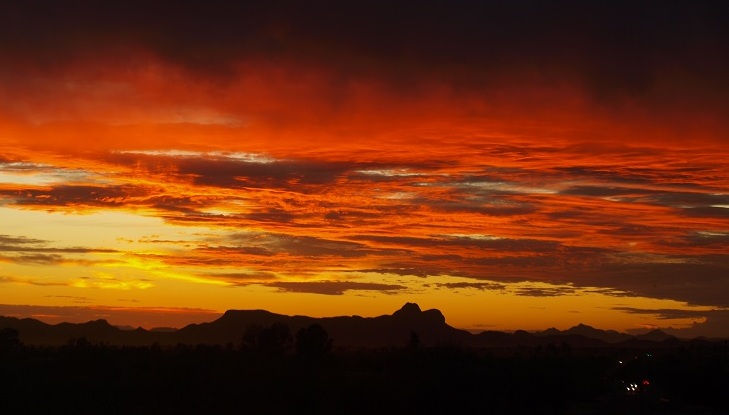
Then when it’s night a yellow moon comes out behind yellow clouds ..

Coldplay knew these things when they sang … “Look at the stars… Look how they shine for you and everything you do ..Yeah, they are all yellow .. they are all yellow…”
Tags: Arizona · Jane St. Clair · nature essay
Kitt Peak by Jane St. Clair
A traveler went all over the world to see holy places like Bethlehem and Mecca .. And yet it was this traveler who said that Kitt Peak was the most spiritual place he’d ever visited.
The beautiful mile-high mountain has great serenity, grace and peace about it, as if it were a natural cathedral. The Tohono O’odham nation, upon whose land Kitt Peak sits, recognize it as the holy place that it is –for it is where their elder brother deity resides. Their creator deity lives on Baboquivari Peak, the sacred center of their cosmology. You can see Baboquivari from Kitt Peak’s fabulous summit.
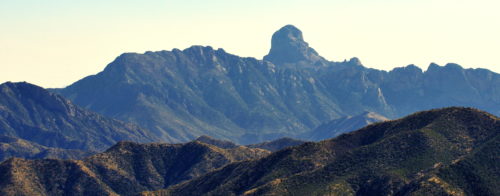
Kitt Peak has the earth’s largest collection of telescopes so you’re seeing this strange mix of high-tech meets mountain wilderness. As you drive up the mountain, the telescopes first look like a field of little R2D2s.

But they are much bigger than Star Wars droids. The Mayall telescope has an 18-foot dome, and it’s so huge that you can see it from 50 miles away.The equipment is crisp and white against the big blue Arizona skies, and it holds all the promise of a sea voyage on a crisp blue day in a white clipper ship.
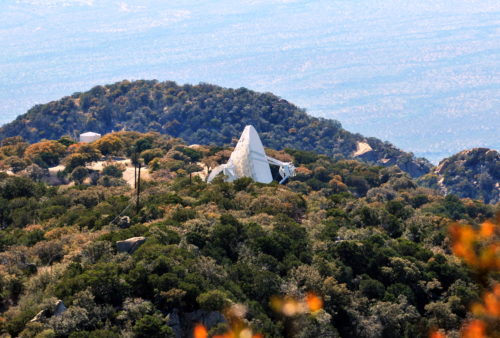 .
.
The various telescopes have different jobs. Some are solar telescopes that make the sun look like a gigantic red fireball with fire flares darting around its edges. But oh! the pictures the night telescopes can make! Pictures of impossibly beautiful colors and amazing shapes! Pictures of billions and billions of stars in billions of galaxies, billions of light-years away!
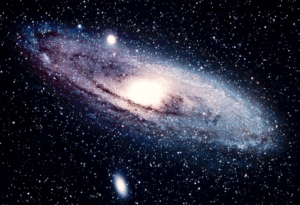

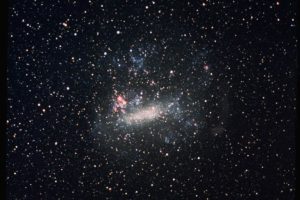
You can go inside some of Kitt Peak’s gigantic telescopes and watch them operate in perfect mechanical symmetry.They move in a high art form, the kind Stanley Kubrick captured perfectly in his movie 2001 when he made intricate technology dance in perfect synchronization to soaring orchestral music.
Plato said, “Astronomy compels the soul to look upwards and leads us from this world to another.” I think that is what makes it a beautiful and benign science. It reminds us that our small planet is part of something beyond ordinary comprehension. It is a science where there are no national identities, no boundaries .. just purity and universality. It is the place where science touches the spiritual.
Vincent Van Gogh understood that intersection because he said once … I have … a terrible need… shall I say the word? … of religion. Then I go out at night and paint the stars.
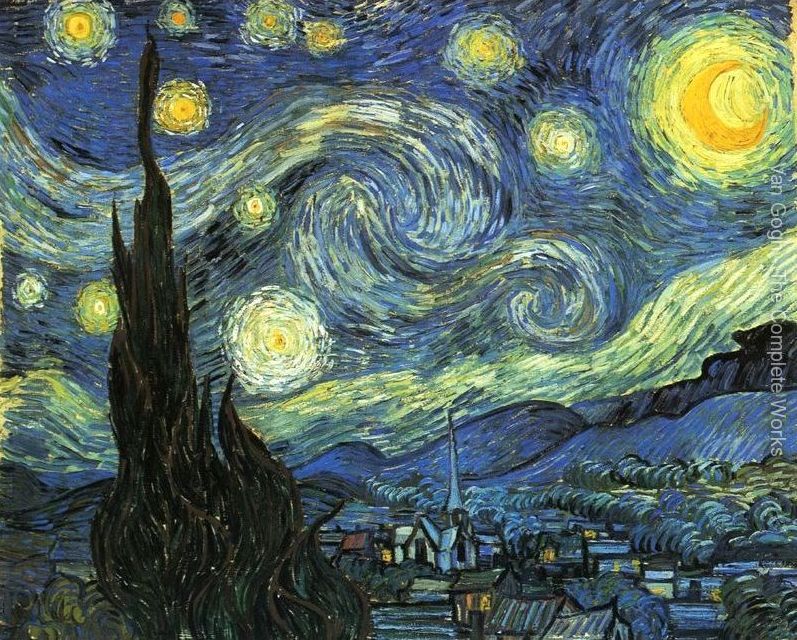
A Starry Night (courtesy of Vincent-Van-Gogh-Gallery.org)







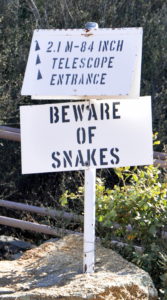


 To plant your visit to Kitt Peak, check out National Optical Astronomy Observatory website
To plant your visit to Kitt Peak, check out National Optical Astronomy Observatory website
Tags: Arizona · Arizona photography · Tucson Tourism
 Anyway, she was walking in Romero Ruins when she picked up some bits of pottery. She took them home. Then for the next five nights, she could not sleep. When she finally did sleep, she had a bad dream. A strange man came to her and spoke in a strange language, yet she could understand him. The next day she knew she must return the pottery chards to Romero Ruins.
Anyway, she was walking in Romero Ruins when she picked up some bits of pottery. She took them home. Then for the next five nights, she could not sleep. When she finally did sleep, she had a bad dream. A strange man came to her and spoke in a strange language, yet she could understand him. The next day she knew she must return the pottery chards to Romero Ruins. You especially do not take a work of art like pottery because every work of art has part of the artist’s spirit/soul in it. You are respectful. You don’t mess with that.
You especially do not take a work of art like pottery because every work of art has part of the artist’s spirit/soul in it. You are respectful. You don’t mess with that.  I was thinking about these things when I last climbed the stairs to Romero Ruins. It is a beautiful spot, very high with beautiful views. I was thinking that it’s a great spot for villages because it is near two big washes and has beautiful panoramic views of mountains and sunsets.
I was thinking about these things when I last climbed the stairs to Romero Ruins. It is a beautiful spot, very high with beautiful views. I was thinking that it’s a great spot for villages because it is near two big washes and has beautiful panoramic views of mountains and sunsets.

